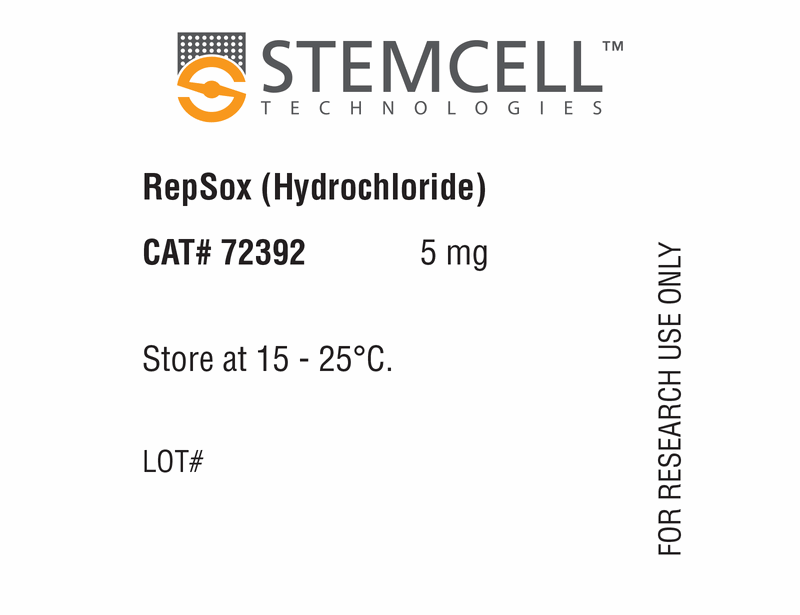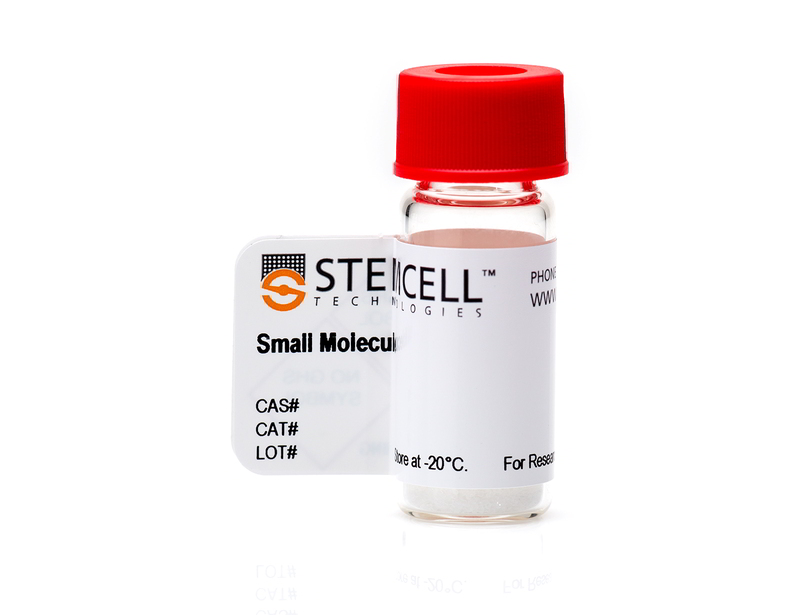概要
RepSox is a cell permeable, selective inhibitor of the TGF-β type 1 receptor (TGFβRI) ALK5 (IC₅₀ = 4, 18, and 23 nM for ALK5 autophosphorylation, TGF-β cellular assay, and ALK5 binding in HepG2 cells, respectively; Gellibert et al.). This inhibitor demonstrated less potent activity (IC₅₀ > 16 μM) against 9 related kinases, including p38 MAPK and GSK3 (Gellibert et al.). This product is supplied as the hydrochloride salt of the molecule.
REPROGRAMMING
· Enhances reprogramming of mouse embryonic fibroblasts (MEFs) that have been transduced with OCT4, KLF4, and c-MYC (Ichida et al.; Subramanyam et al.)
· Direct lineage reprogramming of fibroblasts to mature neurons, in combination with CHIR99021, Valproic Acid, Forskolin, SP600125, Gö6983 and Y-27632 (Hu et al.).
DIFFERENTIATION
· Alone or in combination with forskolin, dexamethasone, and nicotinamide, induces differentiation of human pancreatic progenitor cells into insulin-producing cells (Kunisada et al.; Rezania et al.).
REPROGRAMMING
· Enhances reprogramming of mouse embryonic fibroblasts (MEFs) that have been transduced with OCT4, KLF4, and c-MYC (Ichida et al.; Subramanyam et al.)
· Direct lineage reprogramming of fibroblasts to mature neurons, in combination with CHIR99021, Valproic Acid, Forskolin, SP600125, Gö6983 and Y-27632 (Hu et al.).
DIFFERENTIATION
· Alone or in combination with forskolin, dexamethasone, and nicotinamide, induces differentiation of human pancreatic progenitor cells into insulin-producing cells (Kunisada et al.; Rezania et al.).
技术资料
| Document Type | 产品名称 | Catalog # | Lot # | 语言 |
|---|---|---|---|---|
| Product Information Sheet | RepSox (Hydrochloride) | 72392, 72394 | All | English |
| Safety Data Sheet | RepSox (Hydrochloride) | 72392, 72394 | All | English |
数据及文献
Publications (6)
Cell stem cell 2015 AUG
Direct Conversion of Normal and Alzheimer's Disease Human Fibroblasts into Neuronal Cells by Small Molecules.
Abstract
Abstract
Neuronal conversion from human fibroblasts can be induced by lineage-specific transcription factors; however, the introduction of ectopic genes limits the therapeutic applications of such induced neurons (iNs). Here, we report that human fibroblasts can be directly converted into neuronal cells by a chemical cocktail of seven small molecules, bypassing a neural progenitor stage. These human chemical-induced neuronal cells (hciNs) resembled hiPSC-derived neurons and human iNs (hiNs) with respect to morphology, gene expression profiles, and electrophysiological properties. This approach was further applied to generate hciNs from familial Alzheimer's disease patients. Taken together, our transgene-free and chemical-only approach for direct reprogramming of human fibroblasts into neurons provides an alternative strategy for modeling neurological diseases and for regenerative medicine.
Stem cell research 2012 MAR
Small molecules induce efficient differentiation into insulin-producing cells from human induced pluripotent stem cells.
Abstract
Abstract
Human induced pluripotent stem (hiPS) cells have potential uses for drug discovery and cell therapy, including generation of pancreatic β-cells for diabetes research and treatment. In this study, we developed a simple protocol for generating insulin-producing cells from hiPS cells. Treatment with activin A and a GSK3β inhibitor enhanced efficient endodermal differentiation, and then combined treatment with retinoic acid, a bone morphogenic protein inhibitor, and a transforming growth factor-β (TGF-β) inhibitor induced efficient differentiation of pancreatic progenitor cells from definitive endoderm. Expression of the pancreatic progenitor markers PDX1 and NGN3 was significantly increased at this step and most cells were positive for anti-PDX1 antibody. Moreover, several compounds, including forskolin, dexamethasone, and a TGF-β inhibitor, were found to induce the differentiation of insulin-producing cells from pancreatic progenitor cells. By combined treatment with these compounds, more than 10% of the cells became insulin positive. The differentiated cells secreted human c-peptide in response to various insulin secretagogues. In addition, all five hiPS cell lines that we examined showed efficient differentiation into insulin-producing cells with this protocol.
Nature biotechnology 2011 MAY
Multiple targets of miR-302 and miR-372 promote reprogramming of human fibroblasts to induced pluripotent stem cells.
Abstract
Abstract
The embryonic stem cell-specific cell cycle-regulating (ESCC) family of microRNAs (miRNAs) enhances reprogramming of mouse embryonic fibroblasts to induced pluripotent stem cells. Here we show that the human ESCC miRNA orthologs hsa-miR-302b and hsa-miR-372 promote human somatic cell reprogramming. Furthermore, these miRNAs repress multiple target genes, with downregulation of individual targets only partially recapitulating the total miRNA effects. These targets regulate various cellular processes, including cell cycle, epithelial-mesenchymal transition (EMT), epigenetic regulation and vesicular transport. ESCC miRNAs have a known role in regulating the unique embryonic stem cell cycle. We show that they also increase the kinetics of mesenchymal-epithelial transition during reprogramming and block TGFβ-induced EMT of human epithelial cells. These results demonstrate that the ESCC miRNAs promote dedifferentiation by acting on multiple downstream pathways. We propose that individual miRNAs generally act through numerous pathways that synergize to regulate and enforce cell fate decisions.
Diabetes 2011 JAN
Production of functional glucagon-secreting α-cells from human embryonic stem cells.
Abstract
Abstract
OBJECTIVE: Differentiation of human embryonic stem (hES) cells to fully developed cell types holds great therapeutic promise. Despite significant progress, the conversion of hES cells to stable, fully differentiated endocrine cells that exhibit physiologically regulated hormone secretion has not yet been achieved. Here we describe an efficient differentiation protocol for the in vitro conversion of hES cells to functional glucagon-producing α- cells. RESEARCH DESIGN AND METHODS: Using a combination of small molecule screening and empirical testing, we developed a six-stage differentiation protocol for creating functional α-cells. An extensive in vitro and in vivo characterization of the differentiated cells was performed. RESULTS: A high rate of synaptophysin expression (textgreater75%) and robust expression of glucagon and the α-cell transcription factor ARX was achieved. After a transient polyhormonal state in which cells coexpress glucagon and insulin, maturation in vitro or in vivo resulted in depletion of insulin and other β-cell markers with concomitant enrichment of α-cell markers. After transplantation, these cells secreted fully processed, biologically active glucagon in response to physiologic stimuli including prolonged fasting and amino acid challenge. Moreover, glucagon release from transplanted cells was sufficient to reduce demand for pancreatic glucagon, resulting in a significant decrease in pancreatic α-cell mass. CONCLUSIONS: These results indicate that fully differentiated pancreatic endocrine cells can be created via stepwise differentiation of hES cells. These cells may serve as a useful screening tool for the identification of compounds that modulate glucagon secretion as well as those that promote the transdifferentiation of α-cells to β-cells.
Cell stem cell 2009 NOV
A small-molecule inhibitor of tgf-Beta signaling replaces sox2 in reprogramming by inducing nanog.
Abstract
Abstract
The combined activity of three transcription factors can reprogram adult cells into induced pluripotent stem cells (iPSCs). However, the transgenic methods used for delivering reprogramming factors have raised concerns regarding the future utility of the resulting stem cells. These uncertainties could be overcome if each transgenic factor were replaced with a small molecule that either directly activated its expression from the somatic genome or in some way compensated for its activity. To this end, we have used high-content chemical screening to identify small molecules that can replace Sox2 in reprogramming. We show that one of these molecules functions in reprogramming by inhibiting Tgf-beta signaling in a stable and trapped intermediate cell type that forms during the process. We find that this inhibition promotes the completion of reprogramming through induction of the transcription factor Nanog.
Journal of medicinal chemistry 2004 AUG
Identification of 1,5-naphthyridine derivatives as a novel series of potent and selective TGF-beta type I receptor inhibitors.
Abstract
Abstract
Optimization of the screening hit 1 led to the identification of novel 1,5-naphthyridine aminothiazole and pyrazole derivatives, which are potent and selective inhibitors of the transforming growth factor-beta type I receptor, ALK5. Compounds 15 and 19, which inhibited ALK5 autophosphorylation with IC50 = 6 and 4 nM, respectively, showed potent activities in both binding and cellular assays and exhibited selectivity over p38 mitogen-activated protein kinase. The X-ray crystal structure of 19 in complex with human ALK5 is described, confirming the binding mode proposed from docking studies.

 网站首页
网站首页





